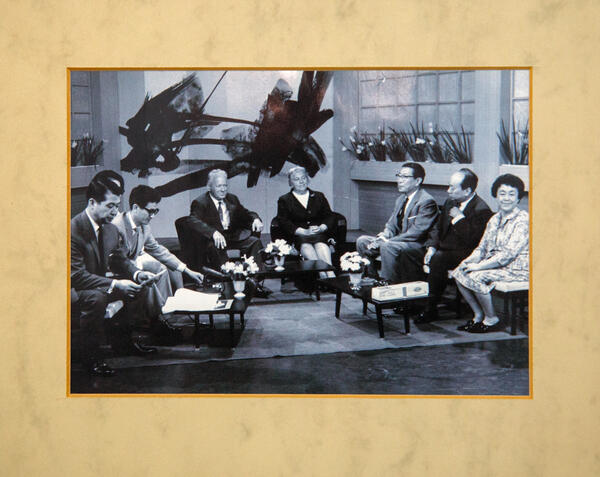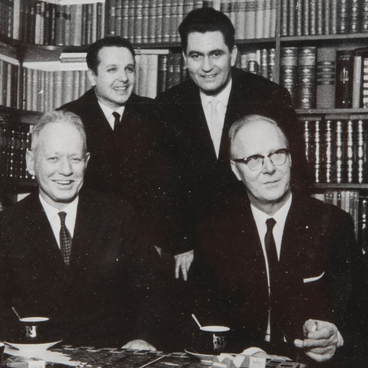Mikhail Sholokhov visited Japan together with his family in 1966. This photo was taken during the writer’s press conference for local television channels.
The photo portrays a group of people. In the center are the famous Soviet writer and his wife. Sholokhov sits in a chair with his arms on the armrests and a cigarette in his right hand. He is wearing a dark suit, a white shirt, and a tie. His wife is dressed in the same colors and sits beside him with her hands in her lap.
The man pictured second from the left, wearing a light-colored suit, a shirt, a tie, and glasses, is Takuya Hara, the translator of Russian classical literature. First from the right is Abe Yoshiya. She was a Japanese journalist, translator, and harp player who contributed greatly to popularizing Sholokhov’s books in Japan. The atmosphere in the studio is filled with cordiality and profound respect for the writer.
During his journey across Japan, Mikhail Sholokhov visited Tokyo, Japan’s ancient capitals Kyoto and Nara, and the industrial hub Osaka. He also visited Nikko and the village of Gifu, near Kawagoe in the Saitama Prefecture. In Tokyo, Sholokhov met actors who performed in the Japanese theatrical production of “Virgin Soil Upturned”. The movie based on this novel was also shown in the cinemas of Japan’s major cities.
News reporters followed Sholokhov everywhere. Japanese newspapers and popular magazines published numerous articles, pieces, and stories describing the writer’s visit. Sholokhov participated in several television programs. These were improvised segments that consisted of conversations, exchanges of opinion, and Q& A sessions.
During one of the press events, Sholokhov told journalists about his impressions of the journey across their country. They asked the writer whether he had noticed anything unpleasant about life in Japan. He responded, “I have not come all the way here to try and find fault with your country.”
The writer’s relatives reminisced that their journey was organized very well, with each of them accompanied by a local representative of their own profession.
This photo entered the Sholokhov Museum-Reserve from the archive of Konstantin Priyma, a literary historian, journalist, writer, and a Sholokhov scholar.
The photo portrays a group of people. In the center are the famous Soviet writer and his wife. Sholokhov sits in a chair with his arms on the armrests and a cigarette in his right hand. He is wearing a dark suit, a white shirt, and a tie. His wife is dressed in the same colors and sits beside him with her hands in her lap.
The man pictured second from the left, wearing a light-colored suit, a shirt, a tie, and glasses, is Takuya Hara, the translator of Russian classical literature. First from the right is Abe Yoshiya. She was a Japanese journalist, translator, and harp player who contributed greatly to popularizing Sholokhov’s books in Japan. The atmosphere in the studio is filled with cordiality and profound respect for the writer.
During his journey across Japan, Mikhail Sholokhov visited Tokyo, Japan’s ancient capitals Kyoto and Nara, and the industrial hub Osaka. He also visited Nikko and the village of Gifu, near Kawagoe in the Saitama Prefecture. In Tokyo, Sholokhov met actors who performed in the Japanese theatrical production of “Virgin Soil Upturned”. The movie based on this novel was also shown in the cinemas of Japan’s major cities.
News reporters followed Sholokhov everywhere. Japanese newspapers and popular magazines published numerous articles, pieces, and stories describing the writer’s visit. Sholokhov participated in several television programs. These were improvised segments that consisted of conversations, exchanges of opinion, and Q& A sessions.
During one of the press events, Sholokhov told journalists about his impressions of the journey across their country. They asked the writer whether he had noticed anything unpleasant about life in Japan. He responded, “I have not come all the way here to try and find fault with your country.”
The writer’s relatives reminisced that their journey was organized very well, with each of them accompanied by a local representative of their own profession.
This photo entered the Sholokhov Museum-Reserve from the archive of Konstantin Priyma, a literary historian, journalist, writer, and a Sholokhov scholar.



